Introduction
The sales profession has been an essential element of business, throughout the US, ever since the earliest times. The origin of contemporary sales practices arose in the late nineteenth and early twentieth centuries with the appearance of large mass manufactures, including Coca-Cola, Eastman Kodak, National Cash Register (NCR), and Westinghouse Electric, established in the 1880s. In the ensuing decade, the market saw the arrival of newly-founded companies such as Burroughs, General Electric, PepsiCo, and Wrigley. Throughout the early 20th century, these and similar companies relied on conventional sales activities, burdened by bureaucracy-bound governance and infrastructures, devoid of substantial systematized support. At that time, the ‘door-to-door’ sales approach heralded as the be-all sales practice for ‘big to medium’ ticket sales required a highly-aggressive personality type to handle rejection and acceptance continually, usually without salary, relying on draws and commissions.
This sales approach lent itself to success in those times as it was the accepted best practice; however, many companies experienced difficulties in driving successful sales productivity efforts and achieving order and financial quotas. Most notably, there was a wide gap between the outcomes of the productivity of rainmakers and the cadre of average salespeople. The conditions that influenced unmet sales plans were, for the most part, traceable to the ‘blind spots’ fashioned from the lack of corporate desire and the ability to change traditional practices. These conditions, fueled by long-standing marketing and sales policies of former times and championed primarily by sacred cow managers, resulted in the fall from prominence and some failures of leading brands.
Business Blind Spots occur when business leaders have a narrow focus that thwarts discovering new concepts or opportunities with the potential of value realization. The Theory of Incongruency suggests that expectations commonly cloud our perception and decision-making. In this state, new ideas are unacceptable, resulting from our disparities with the organization’s existing beliefs of what is relative and valuable to a particular setting.
Sales practices changed dramatically in the late twentieth century with the transformation from primarily an autonomous and unstructured endeavor to an innovative and systematically managed profession that continually contributed to the century’s economic growth. During this time, new management science thinking emerging focusing on changes in B2B and B2C sales practices to improve the salesperson’s productivity and win possibilities. During this period, welcoming changes included marketing and sales organizational restructuring, technology innovation, formal training, and introductions of standardized policies and procedures. However, an array of ‘blind spots’ remained that continue hindered optimal sales performance.
These days, the dynamic and disruptive business environment places extraordinary demands on front-line salespersons to meet commercial quotas. In most market segments, successful salespersons require a balanced mix of well-honed soft skills and technical and business competencies and experiences to establish themselves as trusted business advisors with gravitas. In this empowering consultative-based setting, mature and well-positioned sales professionals can develop rewarding ‘win-win’ business relationships with a focus on crafting customized insight-based solutions that eliminate customer’ pain points and exploit new business opportunities.
Collective research studies reveal that unproductive B2B salespeople have a noticeable dearth of skills and behaviors in recognizing and speaking to their customers’ real business needs. In recent years, the emergence of sales-focused technology has profoundly transformed the type and approach to the services and interactions provided, and empowered decisions made at high-value digital touchpoints. These new approaches envelop the sales activities with technologies, relying not only on employee’s gut feel and experience but also on data analysis and innovative use of AI/machine learning tools for targeting, qualifying, and closing practices enrichment.
With all of the improvements to corporate infrastructures, sales practices, and digital technology enrichments, many companies have not yet gained the necessary traction to support significant growth in sales productivity, and customer wins. Experience shows that the circumvention of an array of sales best practices may result in the building of unwarranted barriers to business achievement. The below graphic highlights a collection of damaging ‘blind spots.’
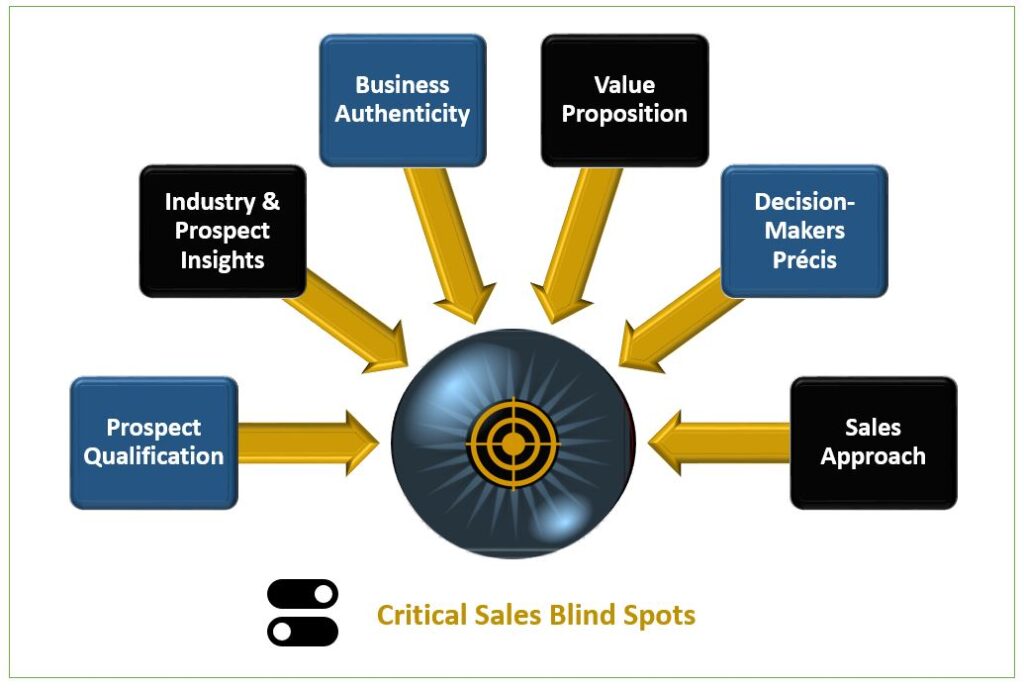
“The key is to set realistic customer expectations, and then not to just meet them, but to exceed them—preferably in unexpected and helpful ways.”
Richard Branson
Sales Blind Spots: The Details
Examples of an ‘Achilles Heel,’ in business settings, are high-value ‘blind spots’ recognized as the most threatening to companies unaware of their existence, adverse impact, and potential value. For sales leaders, one or more ‘blind spots’ may create unfavorable outcomes that hamper effective decision-making, reduce the corporate scope of awareness, and disrupt sales strategies and plans. Unfamiliarity with sales best practices is a definite handicap and risk that should be a required learning and reference point for the management team.
Sales practices’ blind spots’ do not need to be a chronic and lingering dilemma with vulnerabilities that hinder financial outcomes. The initial step to removing a company’s blinders of ‘blind spots’ is to conduct a gap analysis of sales best practices with the existing environment. The following summaries of the six critical sales’ blind spots’ qualities impart the knowledge and supporting insights necessary to lift the uncalled-for blinders and improve overall sales performance.
Business Authenticity
Authenticity encompasses those personal qualities that demonstrate supportive, non-defensive functioning, and psychological maturity. It is all about the conscious mending of the incongruencies between one’s inner self and outer self. Part of being authentic is standing up for what we believe in and speaking the truth, even if it is not what others want to hear! In a business setting, authenticity is about being consistent in word and deed, exhibiting the healthy positive underlying behaviors in the workplace and social activities. It is only natural that most people identify and desire to befriend and associate with trustworthy individuals. What people want in business dealings is simply a genuine and transparent experience and nothing that reeks of being phony, false, or copied. Expectedly, we avoid frauds and shams as we pursue friends and colleagues recognized as authentic.
“79% of business buyers say it’s absolutely critical or very important to interact with a salesperson who is a trusted advisor — not just a sales rep — who adds value to their business.”
Salesforce.com, inc.
Salespeople represent the primary contact with the public, customers, and prospective buyers. Their professional behaviors influence the ability to win business and impact the company’s awareness and opinion in the market. Authenticity is generally an element of the company’s culture, as expressed in the corporate brand. Consumers respond positively to sales experiences that are authentic, transparent, and engaging. Cultural and policy edicts should empower sales professionals to continually reflect this dominant trait in their communications and interactions with prospects and customers.
It is no secret that buyers demand salespersons to be straightforward and transparent in their dialogue and exchanges. Companies typically fail to recognize salespeople’s behavior shortcomings, lacking proper control in hiring, career development, and performance management. Best practices encourage periodic assessments that value sales professionals’ behaviors and employ remedial programs for behavioral improvements. The metamorphosis to a more transparent sales rep may be painful at first, but the discomfort will be replaced quickly with improved success in winning over prospects with positive behaviors.
Most people are genuinely attracted to authentic salespeople because they put the prospect first, which makes for a much more pleasing experience than selling something they may not want or value.

“Prospects must believe you before they’ll buy from you! And that’s a lot tougher to do than you think it is.”
Bill Brooks
The Universal Sales Management Truths
Humanistic psychologists report that authentic people possess an array of common characteristics that show they are psychologically mature and fully functioning persons, as shown below.
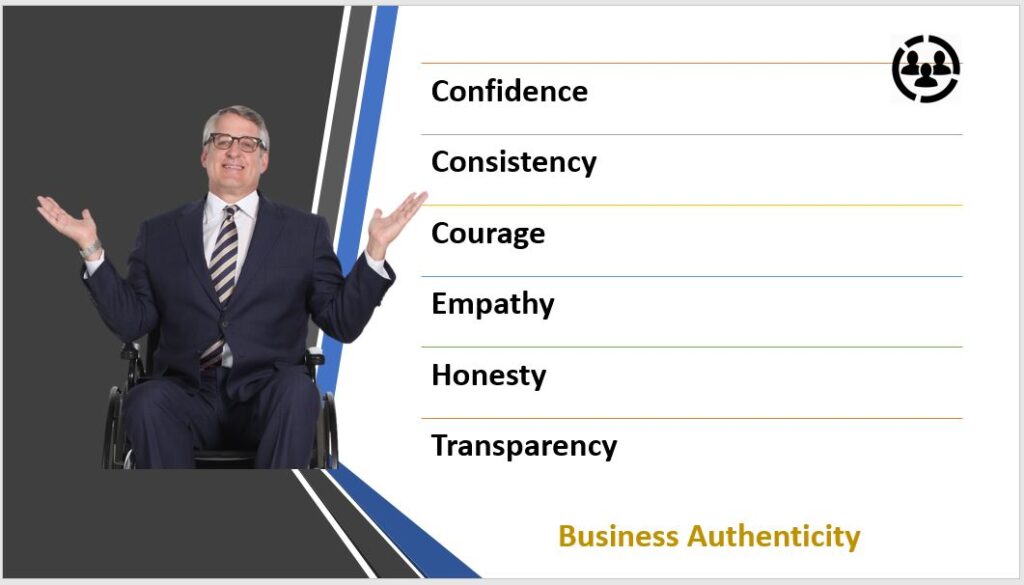
The benefits realized with a successful application of authenticity behaviors within the sales activities include:
- Improve the market’s understanding and value of the business and offerings.
- Validate the company as a trustworthy and honorable brand.
- Provide substance to the company, products, and services.
- Humanize the company’s culture and personality.
“In a recent survey, 91 percent of consumers around the world ranked “communicating honestly about products and services” as the top influence on whether or not they do business with a company.”
Score Association
Value Proposition
A value proposition refers to the tangible benefits a company pledges to deliver to customers should they choose their product or services. It communicates the offering’s key features and differentiation over competitive products. A best practice followed by many successful brands is crafting a general value proposition in a template format for customization for particular sales situations. A successful Value Proposition provides clarity, focuses on core benefits, and explains why the product is superior to competitive offerings.
The term “Value Proposition” (VP) attributed to McKinsey and Company, who first used the catchphrase in a 1988 staff paper. The report introduced a concept of customer value, with business insights responsible for driving a company’s marketing activities.
Creating a Value Proposition begins with the targeted customer segment and an awareness of their unique needs. Each grouping may have a distinct value proposition highlighting the benefits that are most relevant to them. The success of any value proposition is whether the benefits of the product or service outweigh the cost to the customer. The aim is to maximize the value realized by customers.
Value Propositions are created in both generic formats and personalized for use within an individual sale process. Both efforts follow a similar production and sequence with personalized versions requiring prerequisite analysis of the potential opportunity with prospective decision-makers. The outline below consists of the logical steps for completing winning value propositions.
- Identify the primary business trends and innovation developments that drive the need for new or enriched current products and services in target markets and segments.
- Profile the company’s products and services that meet real or potential needs, as discovered above.
- Associate and connect the benefits potentially realized from successful customer employment of the company’s product and service.
- Describe how the identified benefits are achievable within practical use case scenarios.
- Benchmark and differentiate company offerings with the leading market competition.
- Uncover the prospect’s problem or opportunity and root causes. (Personalized Version)
- Connect the company’s product or service benefits with prospect uncovered needs. (Personalized Version)
- Highlight the company’s satisfied and loyal customer’s satisfaction level and loyalty on focused products and services.

HubSpot Value Proposition research reports the vital statistics on the use within the business community.
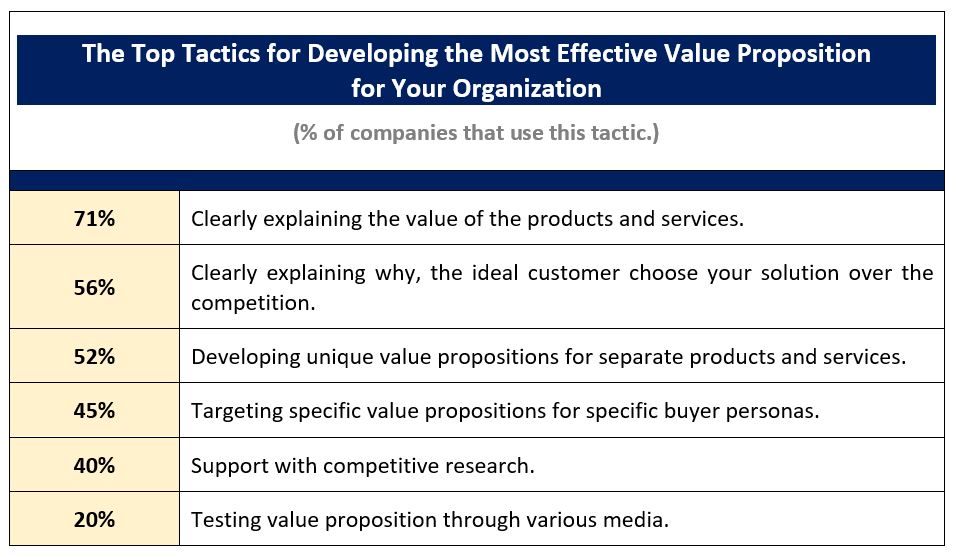
A Value Proposition encompasses a set of essential characteristics, including:
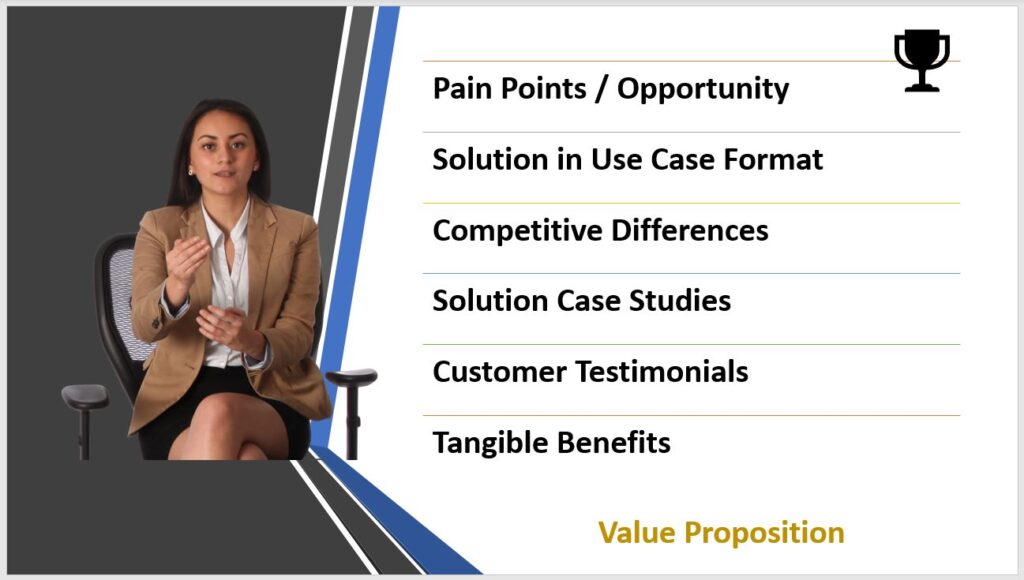
The benefits realized with a successful application of the value proposition within the sales activities include:
- Convey the company’s competence and quality as embedded in products, services, and supporting business activities through clarity of messaging.
- Highlight the differentiation benefits of the company’s products and services with known competitive offerings.
- Redefine the prospect’s purchase criteria with the provision of compelling business insights with tangible commercial value.
- Attract high-value prospects and increases not only the quantity but the quality of prospective leads.
“Consistent alignment of capabilities and internal processes with the customer value proposition is the core of any strategy execution.”
Robert S. Kaplan
Industry & Prospect Insights
Currently, survival, emotion, and logic represent the primary behaviors that drive high-ticket B2B purchasing decisions. Experience finds that most choices are attributable, in whole or part, to the survival driver. This vital human behavior is an essential decision stimulus for individuals with concerns to safeguard their professional existence and future career opportunities. Primarily, they are motivated by a corporate culture that rewards success and punishes failure, where survival is a key influencer.
A valuable sales approach to support the survival mode is to create insight-based scenarios showing how prospects may obtain improved business results in line with their unique needs filtered with topical industry trends and competitive demands. Insights positioned smartly for recognition and attraction by prospect decision-makers with survival mode tendencies can be strongly influenced by inferences from their emotional intelligence and logic behaviors.
In marketing and sales speak, ‘leading with insights’ means crafting and promoting personalized business scenarios in responding to a prospect’s business problem or opportunity. High-value insights incorporate a meshing of contemporary economic statistics and trends, competitive benchmarks, and prospect firmographic, technographic, and demographic data. Consider business insights to be any business material capable of influencing the prospect’s purchasing decision through synergy with potential uses and outcomes. In summary, leading with insights is all about challenging the customer to rethink their business activities through innovation and enabling change approach filters.
Obtaining the interest of decision-makers early in the sales process is a common challenge and critical to winning. Salespersons who can positively frame real business problems or opportunities within topical insights are more likely to gain traction with decision-makers quickly. This approach generally creates a substantial advantage over sales organizations favoring selling products generically without investing the time and effort to understand the prospect’s real business problems and opportunities needs and root causes. Leveraging insights use within the sales process and supporting methodology is becoming a widespread best practice in the empowered customer’s age.
CEB Research (Gartner, Inc.) reports that the typical B2B buyer delays contacting a seller until 57% through their investigation and analysis effort. In the current environment, corporate sales prospects are reluctant, risk-averse, and empowered as they do independent research and have their informed criteria for procuring products and services. This trend reinforces the need for sales leaders to consider the use of business insights as well-informed prospects expect that the seller can talk to the same business conditions and trends uncovered in their research activities.
The sales process should always be about the prospective customer! Many companies have a mistaken belief in spotlighting the sales team and the company. Every interaction should be related to one or many insights that impact the prospect’s business. However, some sales reps exhibit “show up and throw up” behaviors with an emotional need to impress prospects with their product knowledge and expertise. Generally, these individuals attempt to continually over talk meetings with excessive meaningless, irrelevant, and self-serving conversation centered on the product or company. This behavior should be discouraged and replaced with a primary focus on prospect needs and a buying versus a selling approach supported with relevant insights.
Many companies use a cornucopia of approaches, tools, and sources to discover, gather, manipulate, and generate pertinent targeted industry and company background and statistical information, including demographic and behavioral data. Conventional collection methods include innovative software solutions and services that collect data from websites, social media platforms, internet of things (IoT) digital devices, and sourcing of packaged or customized data from information providers. As AI/machine learning algorithms proliferate and improve, data analytics becomes an even more powerful for assessing and creating actionable insights.
Today, many companies are drowning in data, lacking insights, and failing to convert information into actionable knowledge effectively. For the most part, there is a lack of a shared sense of a consensus definition of insight that represents one explanation. The non-existence of the methodological rigor necessary for successful insight production is another. Experience shows that most business insights’ are sadly nothing more than comments, reporting topical headlines from a particular business segment without supporting data.
How do you know that an ‘insight’ is ready for prime time use within the sales process? Commonly, ‘insights’ are recognized as valid and high value when they influence prospects by:
- Connecting with the prospect’s decision-maker on an intellectual level.
- Disrupting the existing business conventions and challenging the status quo of the prospect’s culture and decision-making.
- Providing new connections and approaches to solving chronic problems or exploiting potential opportunities.

Industry & Business Insights encompasses a set of critical data points, including:
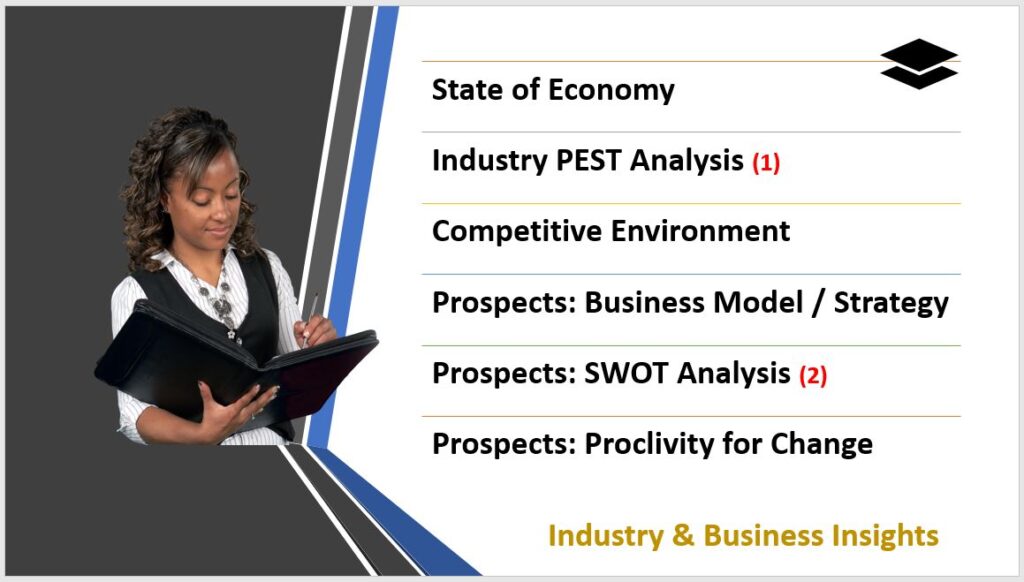
Notes:
- PEST Analysis: (Political, Economic, Socio-cultural, and Technological) defines a structure of macro-environmental elements used in environmental scanning when conducting strategic analysis and conducting market research.
- SWOT Analysis: (Strengths, Weaknesses, Opportunities, and Threats) is a strategic planning method to identify a company’s strengths, weaknesses, opportunities, and threats of the overall business.
The benefits realized with a successful application of the industry and company insights within the sales activities include:
- Building business and technical acumen and credibility with the decision-makers.
- Creating a sense of urgency for purchasing.
- Disrupting the prospect’s current mindset and purchase decision-making.
- Changing view with the prospect (customer) from a salesperson to ‘trusted advisor.’
Salesforce reports specific research statistics that support the use of industry and business insights, as outlined below.
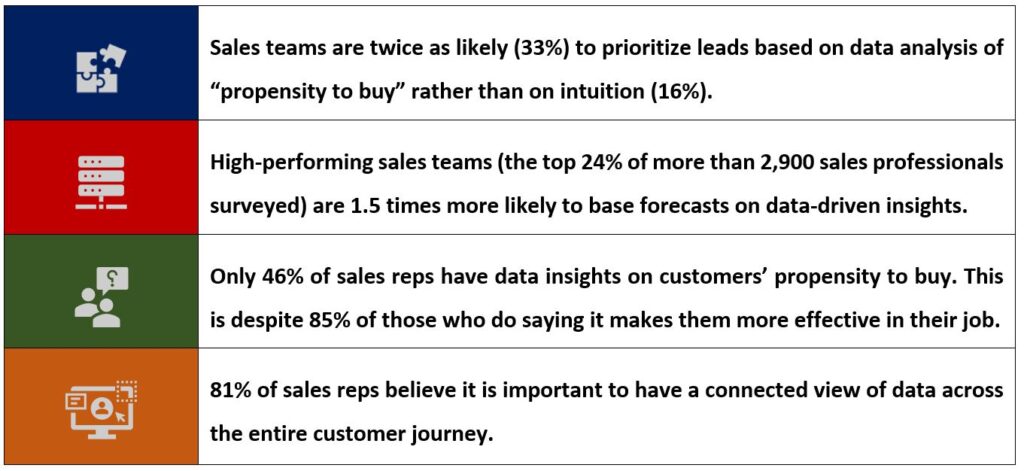
“Gartner research shows that sales reps who disrupt customer thinking with commercial insight during the solution exploration stage are 41% more likely to win a high-quality deal. During this stage, sales reps are able to disrupt the root cause of the customer’s problem and show them a solution they might not have considered or explored on their own.”
Gartner, Inc.
Decision-Maker Précis
Entering a sales cycle without gathering and understanding the prospect’s decision-maker(s) background and personality is a formula for failure. The more known about the contact and business, before the initial interaction, increased the success for prospect favorability. Most B2B prospects are attracted to salespeople that arrive at the first meeting knowledgeable about their company and industry, gleaned from research and analysis, and able to understand their difficulties and needs quickly.
Traditionally, prospecting focused on identifying and working with a single contact person considered to be the critical B2B decision-maker. Over the years, many companies have set-up effective information collection and analysis routines to identify the appropriate prospect personas and decision-makers for particular sales campaigns. However, many businesses report mixed results. For example, a smaller business population failed to recognize the value of this critical data point and sourced all prospect key names and roles from websites and other media without verification.
Much research, of Fortune500 businesses, supports the significant amount of pipeline prospects abandoned lacking qualification primarily from the absence of identified responsible decision-makers. Working with non-decision-makers, as the primary contact, invariably extends the sales cycle and increases the cost for those prospects that eventually prove successful.
Over time the number of decision-makers involved with the sales process has increased. The trends driving these requirements include changing employee responsibilities and governance, decentralizing organizational structures, and disseminating and universal product use across the enterprise’s business activities. The employees who may influence purchases now may be found to work and scattered throughout many of the company’s business divisions globally.
In addition to the ‘Decider’ and ‘Buyer’ decision-maker, there is an array of shadow “influencers” concerned with purchasing decisions whose connection may be less than transparent to the sales team. It is essential to understand that job titles and titles vary across companies, and organization industry segment and size are considered factors in the identification process. Best practices encourage the use of relationship mapping to visualize relationships within prospective companies. Such charting can identify the types of employees with unique positions and titles that participate in particular purchasing decisions.
Key decision-makers often insulate themselves with gatekeepers who are instrumental in stopping or just slowing down the sales process. While these individuals may make scheduling audiences with decision-makers more challenging, identifying multiple contacts and leading with an attractive insight-based focus should breakdown this defensive tactic.
The types of generic decision-makers found participating in many B2B purchasing decisions cover the below groups.

The number one sales goal is to identify each prospect’s responsible ‘Decider.’ If there is no ‘Decider,’ then there is no sale!
How should sales executives deal with the need to establish relationships and interact with multiple prospect deciders and shadow influencers? A best practice is to identify as many responsible decision-makers and influencers for prospects as possible. This approach is essential to ensure that the sales cycle does not encounter a roadblock, even if one reliable connection departs or shifts roles within the company.
As all employees fulfilling purchasing roles are human, their decisions likely are influenced by their personality and associated behaviors. Understanding the particular prospect’s decision-making personality types and guiding them through the sales process within this reference set is critical for successful sales outcomes. All sales communications with decision-makers need personalization and filtering through a standard set of personas, as presented below.

Decision-maker profile data and personal insights are compelling intelligence that generates actionable input to a prospect sales approach when coupled with company sales policies, guidelines, and cultural influences. The unearthed data may result in “eureka moments” that drive the changing or augmenting personalized plans for sales tactics, approaches, and techniques with prospects. This practice may alter awareness about the significance or weight of a situation (problem, risk, or opportunity) and strengthen the social connection between the salesperson and prospect contact.

Contact Background & Insights encompasses a set of essential characteristics, including:
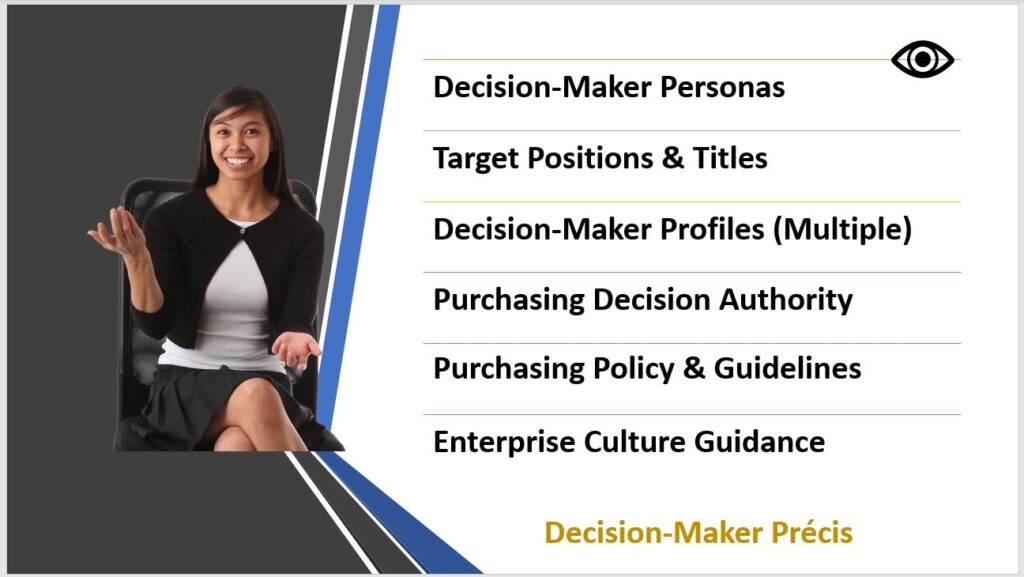
The benefits realized with successful identification of responsible decision-makers within the sales activities include:
- Decrease qualifying the wrong contacts.
- Decrease prospect abandonment.
- Reduce sales resources: time and money.
- Shortens the sales cycle.
“Get closer than ever to your customers. So close that you tell them what they need well before they realize it themselves.”
Steve Jobs
Prospect Qualification
Almost all selling, regardless of the product or service on offer, follows a particular sequence and activities. The typical generic sale process divided into discrete and logical steps empower companies to successfully progress a lead to a prospect status and then elevate to the customer level. The initial stage of an effective sales campaign is the formal qualification of the leads.
Qualification is the act of assessing leads to determine whether they have the qualities that make them a prospect with a good fit for a product or service. A qualified lead is a prospect that has expressed a strong need and interest in the seller’s products or services. Experience supports that qualified sales leads have a higher return on investment and a higher close rate. Failing to hit sales targets directly impacts a company’s financial results. Best practices support conducting formal and documented qualification exercises to establish whether collected leads are genuine prospects by discovering their readiness for purchasing.
There are apparent indicators that point to those leads with a penchant for purchasing particular products and services. These values are generally identified among suspects with information collected, systematized, and analyzed throughout prospecting, industry, and business insight research, and contact presales activities. Companies with innovative AI/machine learning solutions have the upper hand in providing superior support identifying suitable prospects for the sales team to qualify.

During qualification, salespeople should identify and associate with the positive indicators that represent the preconditions encouraging favorability to their offering. The qualities presented in the below graphic represent the conditions that generally determine a lead as a high-priority prospect.
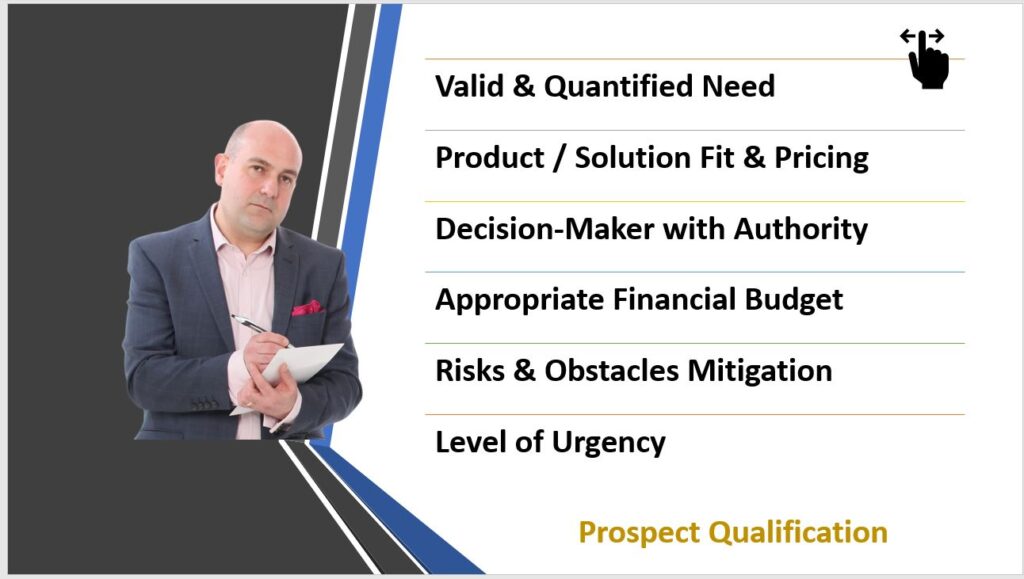
The benefits realized with acceptance, and successful application of the prospect qualification practice include:
- Improve financial projections as qualified prospects have a higher percentage of closing.
- Improve productivity by not wasting time spent on leads without the ability for conversion to prospect opportunities.
- Increased opportunities from a redirected focus on qualified high-priority deals with the quick identification and closeout of unqualified leads.
- Reduce the overall cost of managing lead to prospect to customer sales activities.
“Every sale has five basic obstacles: No need, no money, no hurry, no desire, no trust.”
Zig Ziglar
Sales Approach
The sales approach, recognized as an art form, has been employed and engaged in many different but similar variations across the business community. Most business professionals are comfortable with Sales Process and Sales Methodology as the principal organizational and governance practices supporting successful corporate sales activities. However, naming and misuse of these practices have resulted in failed set-ups and unplanned after-effects among marketing and sales groups throughout businesses.
Sales Process and Sales Methodology practices are commonly confused in definition, use, and outcomes, within marketing and sales disciplines. The unintentional or mistaken use of either term matters because of their intended purposes and need for harmonization interaction and dialogue. Any confusion among these terms is an unwelcome distraction that invariably leads to workplace productivity and financial plan disappointments. The lack of an appropriate sales methodology to support the sales process and vice versa typically weakens accountability at all levels. The favored action to removing any ambiguity is to study, understand, and appreciate the unique differences, nuisances, and value of both critical tools employed holistically within the business.
The sales process is a roadmap that salespersons use to convert leads to prospective opportunities and then customers, within a multi-stage sequence. Conversely, the sales methodology is the structure that reinforces and strengthens the sales process by referencing corporate sales policies and strategies and incorporating tailored best practices. The method represents a unique, customized approach to enabling sales effectiveness and continually developing high-performance sales competencies.
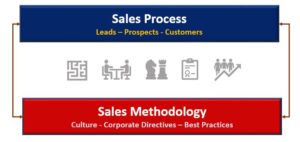
If the ‘Sales Process’ is the map, then the ‘Sales Methodology’ is the resources to ensure a successful sales journey, including corporate guidance, training, collateral, best practices, and supporting techniques and tools.
“The fatal flaw in selling occurs when you are so focused on what you want to happen that you lose sight of what the prospect wants to happen.”
Bill Brooks
The Universal Sales Management Truths
Sales Process
The sales process is a customizable tool with a set of repeatable, and trackable stages used to convert potential leads to prospects and then to customers. The practice functions as a roadmap, with highway signposts and guard rails that empower steer, and track sales professionals’ presales activities and milestones within a formal setting from the start to the end, with verifiable outcomes. The process also serves as a communication tool that helps articulate the company’s sales strategic thinking, the why, behind both the sales goals and strategies. An effective sales process allows salespeople to identify, qualify, diagnose, and measure opportunities and determine subsequent in progressing to a successful close.
Sales processes structured with a series of stages allow for the incorporation of best sales practices that improve outcomes. Different sales models exist within the business community, with the seven and five-stage sales process being the most common ones. The stages of a sales process demonstrate the progression of an opportunity. These stages should align with the company’s CRM system. The sales process is distinct for different businesses, but some elements tend to be similar. The most popular stages include prospecting, qualification, needs assessment, pitch, proposal, objections handling, closing, and follow-up. The sales process needs customization from its generic format in alignment with the business sales goals and strategies. For example, each stage, supporting activities, and metrics should project the company’s value proposition.
A sales process requires systemized oversight of the execution with the collection and assessment of actionable business intelligence. The first step to attaining an effective sales oversight process is identifying the metrics that represent the quantifiable markers for illuminating sales productivity and goal achievement. Still, it is all too familiar, that many companies, disregard or weaken the scope of sales analysis data and reports produced. Sales teams that adequately define, monitor, and assess relative key performance indicators (KPIs) are in a better position to improve prospect to customer sales process experiences continually and meet their financial plans.
Presented below are the essential metrics found in well-managed sales oversight frameworks.
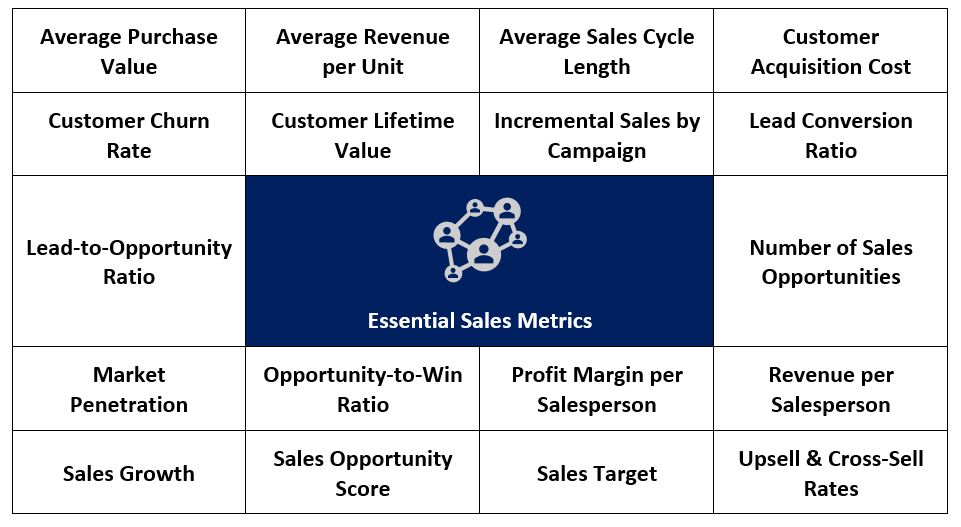
Sales Methodology
The sales methodology is a set of corporate sales-based directives, recognized best practices information, and non-linear procedures that provide the reasoning and strategic purpose of the company’s sales process. The methodology must provide the fuel to successfully operate the sales process engine continually as a sound, repeatable, and scalable presales tool. A sales methodology consists of multiple slices that reference specific sales process stages and deployed and used simultaneously.
It is essential to understand that a sales process is unable to exist with a supporting sales methodology. Nor is one of these sales approach components a substitute for the other. Companies can enhance their sales process with one or more sales methodologies but cannot ignore the underlying process.

The Sales Approach encompasses a set of essential characteristics, as shown below.
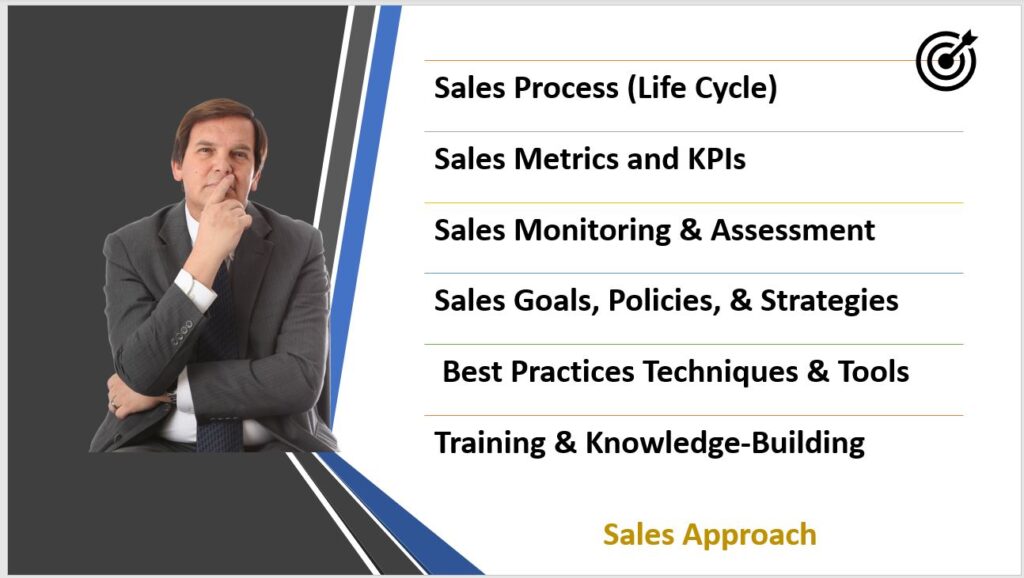
The benefits realized from the set-up, and continual enhancement of the sales approach process and methodology are as follows:
- Align sales activities with company sales policies and strategies.
- Provide a framework for successfully navigating a changing economy and business environment.
- Create a common language for describing the steps required at each stage of the sales process with supporting methodology corporate and best practices reference points.
- Collapse individual sales processes and increase productivity.
“To provide customers with greater value across the purchase process‚ sales leaders first need to recognize just how different buying has become. Within that new reality, they must address what customers actually need to complete a purchase to their satisfaction and‚ as a result‚ how to equip reps differently to succeed.”
Gartner, Inc.
The Way Forward
At Knowledge Compass we bring together nearly four decades of thought leadership in business and technology strategy, the latest tools and best practices, and a seasoned consultant team with the competencies and talent to help our clients improve productivity and profitability of all enterprise business and support activities.
Knowledge Compass explores and develops valuable new insights from business, technology, and science by embracing the powerful technology of ideas and brainstorming. Our consultants engage customers in challenging discussion and experimentation to expand the boundaries of business science and practice and translate creative ideas into practical solutions from within and beyond business.
Working with Knowledge Compass means a collaborative approach to understanding your current business model, strategies, and key business requirements and goals.
We enable organizations to transform and deliver improved value by ensuring employees adapt and make the most effective use of creativity and innovation practices in improving the capabilities of marketing and sales capabilities. Our consultants have a deep understanding and appreciation of the social and business factors that support innovative marketing and sales best practices.
Knowledge Compass provides consulting services with the use of an array of Frameworks, Analyses Tools, and Interactions from their Best Practices Consultant Toolbox.



